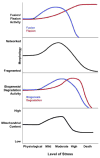Mitochondrial fusion, fission, and mitochondrial toxicity
- PMID: 28789970
- PMCID: PMC5681418
- DOI: 10.1016/j.tox.2017.07.019
Mitochondrial fusion, fission, and mitochondrial toxicity
Abstract
Mitochondrial dynamics are regulated by two sets of opposed processes: mitochondrial fusion and fission, and mitochondrial biogenesis and degradation (including mitophagy), as well as processes such as intracellular transport. These processes maintain mitochondrial homeostasis, regulate mitochondrial form, volume and function, and are increasingly understood to be critical components of the cellular stress response. Mitochondrial dynamics vary based on developmental stage and age, cell type, environmental factors, and genetic background. Indeed, many mitochondrial homeostasis genes are human disease genes. Emerging evidence indicates that deficiencies in these genes often sensitize to environmental exposures, yet can also be protective under certain circumstances. Inhibition of mitochondrial dynamics also affects elimination of irreparable mitochondrial DNA (mtDNA) damage and transmission of mtDNA mutations. We briefly review the basic biology of mitodynamic processes with a focus on mitochondrial fusion and fission, discuss what is known and unknown regarding how these processes respond to chemical and other stressors, and review the literature on interactions between mitochondrial toxicity and genetic variation in mitochondrial fusion and fission genes. Finally, we suggest areas for future research, including elucidating the full range of mitodynamic responses from low to high-level exposures, and from acute to chronic exposures; detailed examination of the physiological consequences of mitodynamic alterations in different cell types; mechanism-based testing of mitotoxicant interactions with interindividual variability in mitodynamics processes; and incorporating other environmental variables that affect mitochondria, such as diet and exercise.
Keywords: Biomarker; Gene-environment interactions; Mitochondrial DNA; Mitochondrial dynamics; Mitochondrial fission; Mitochondrial fusion; Mitochondrial homeostasis; Mitochondrial toxicity.
Copyright © 2017 Elsevier B.V. All rights reserved.
Conflict of interest statement
The authors declare no conflict of interest.
Figures


References
-
- Amati-Bonneau P, Valentino ML, Reynier P, Gallardo ME, Bornstein B, Boissiere A, Campos Y, Rivera H, de la Aleja JG, Carroccia R, Iommarini L, Labauge P, Figarella-Branger D, Marcorelles P, Furby A, Beauvais K, Letournel F, Liguori R, La Morgia C, Montagna P, Liguori M, Zanna C, Rugolo M, Cossarizza A, Wissinger B, Verny C, Schwarzenbacher R, Martin MA, Arenas J, Ayuso C, Garesse R, Lenaers G, Bonneau D, Carelli V. OPA1 mutations induce mitochondrial DNA instability and optic atrophy ‘plus’ phenotypes. Brain. 2008;131:338–351. - PubMed
Publication types
MeSH terms
Substances
Grants and funding
LinkOut - more resources
Full Text Sources
Other Literature Sources

